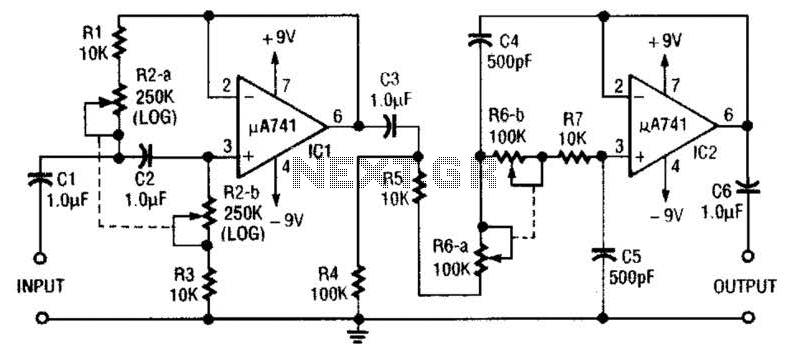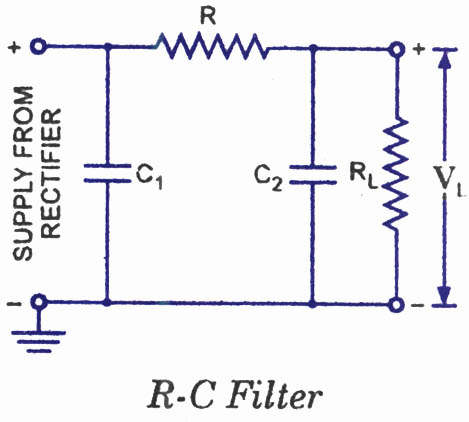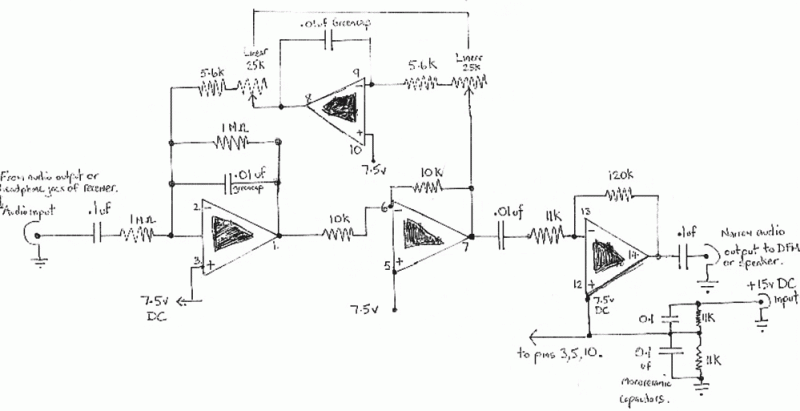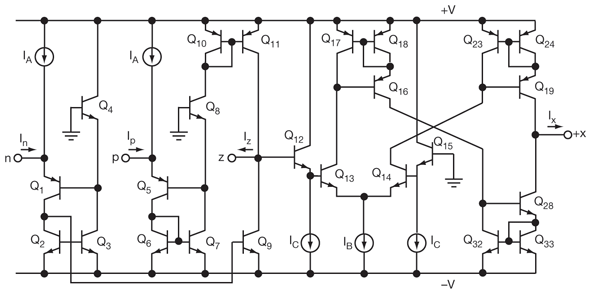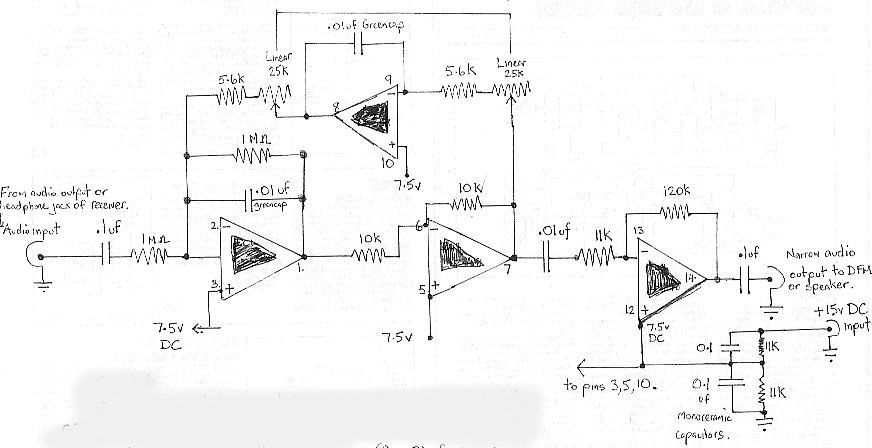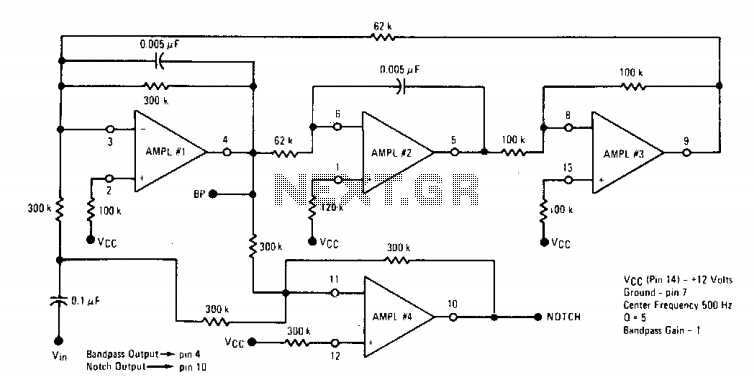
Cascade bandpass filters for higher Q
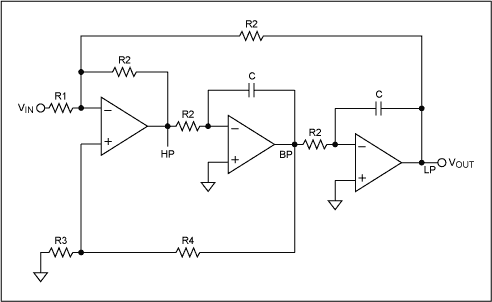
Switched-capacitor filters that are preset for a given bandwidth sometimes do not deliver the bandwidth or Q an application requires. By inverting the clock between two switched-capacitor bandpass filters, such as the MSFS1 from Mixed Signal Integration Corp, you can configure a high-Q filter. The MSFS1 is a selectable, seventh-order, lowpass/bandpass, switched-capacitor filter. Using the FSEL pin, you can select either a lowpass or a bandpass response. With the TYPE pin, you can select a Butterworth, a Bessel, or an elliptic response if FSEL is low.
The described circuit utilizes switched-capacitor technology to create filters with adjustable bandwidth and quality factor (Q). The MSFS1 filter is notable for its versatility, allowing designers to select different configurations to meet specific application requirements.
The operation of the MSFS1 involves the use of a clock signal to control the switching of capacitors. By inverting the clock signal between two MSFS1 units, a high-Q filter configuration can be achieved. This inversion effectively alters the timing of the charge and discharge cycles of the capacitors, leading to enhanced filter performance characteristics.
The FSEL pin is crucial for defining the filter type; setting this pin low configures the filter to operate in either lowpass or bandpass mode. This flexibility is important in applications where the desired frequency response may change. Additionally, the TYPE pin allows for the selection of different filter responses, including Butterworth for a maximally flat frequency response, Bessel for a linear phase response, or elliptic for a sharper roll-off at the expense of ripple in the passband.
In practical applications, the MSFS1 can be integrated into various electronic systems where precise filtering of signals is required, such as in audio processing, communication systems, or instrumentation. The ability to adjust the filter characteristics dynamically makes it a valuable component in modern electronic design.
Proper implementation of the MSFS1 involves careful consideration of external components, such as resistors and capacitors, to ensure stability and performance. The design should also account for power supply decoupling and layout considerations to minimize noise and interference, which are critical for maintaining the integrity of the filtered signals.Switched-capacitor filters that are preset for a given bandwidth sometimes do not deliver the bandwidth or Q an application requires. By inverting the clock between two switched-capacitor bandpass filters, such as the MSFS1 from Mixed Signal Integration Corp, you can configure a high-Q filter (Figure 1).
The MSFS1 is a selectable, seventh-order, lowpass/bandpass, switched-capacitor filter. Using the FSEL pin, you can select either a lowpass or a bandpass response. With the TYPE pin, you can select a Butterworth, a Bessel, or an elliptic response if FSEL is low. 🔗 External reference
The described circuit utilizes switched-capacitor technology to create filters with adjustable bandwidth and quality factor (Q). The MSFS1 filter is notable for its versatility, allowing designers to select different configurations to meet specific application requirements.
The operation of the MSFS1 involves the use of a clock signal to control the switching of capacitors. By inverting the clock signal between two MSFS1 units, a high-Q filter configuration can be achieved. This inversion effectively alters the timing of the charge and discharge cycles of the capacitors, leading to enhanced filter performance characteristics.
The FSEL pin is crucial for defining the filter type; setting this pin low configures the filter to operate in either lowpass or bandpass mode. This flexibility is important in applications where the desired frequency response may change. Additionally, the TYPE pin allows for the selection of different filter responses, including Butterworth for a maximally flat frequency response, Bessel for a linear phase response, or elliptic for a sharper roll-off at the expense of ripple in the passband.
In practical applications, the MSFS1 can be integrated into various electronic systems where precise filtering of signals is required, such as in audio processing, communication systems, or instrumentation. The ability to adjust the filter characteristics dynamically makes it a valuable component in modern electronic design.
Proper implementation of the MSFS1 involves careful consideration of external components, such as resistors and capacitors, to ensure stability and performance. The design should also account for power supply decoupling and layout considerations to minimize noise and interference, which are critical for maintaining the integrity of the filtered signals.Switched-capacitor filters that are preset for a given bandwidth sometimes do not deliver the bandwidth or Q an application requires. By inverting the clock between two switched-capacitor bandpass filters, such as the MSFS1 from Mixed Signal Integration Corp, you can configure a high-Q filter (Figure 1).
The MSFS1 is a selectable, seventh-order, lowpass/bandpass, switched-capacitor filter. Using the FSEL pin, you can select either a lowpass or a bandpass response. With the TYPE pin, you can select a Butterworth, a Bessel, or an elliptic response if FSEL is low. 🔗 External reference
Warning: include(partials/cookie-banner.php): Failed to open stream: Permission denied in /var/www/html/nextgr/view-circuit.php on line 713
Warning: include(): Failed opening 'partials/cookie-banner.php' for inclusion (include_path='.:/usr/share/php') in /var/www/html/nextgr/view-circuit.php on line 713
